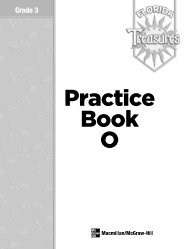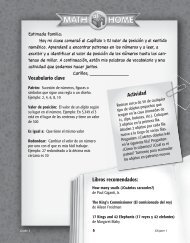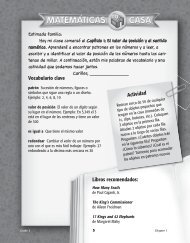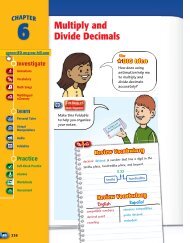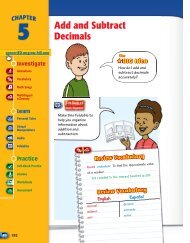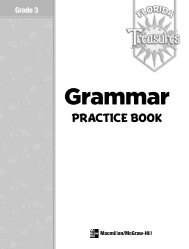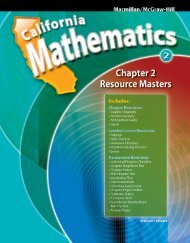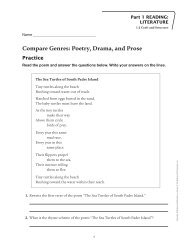Practice - Macmillan/McGraw-Hill
Practice - Macmillan/McGraw-Hill
Practice - Macmillan/McGraw-Hill
Create successful ePaper yourself
Turn your PDF publications into a flip-book with our unique Google optimized e-Paper software.
Name<br />
When you read poetry, pay attention to features often used with<br />
poetic language. For example, poems often include repetition, which<br />
occurs when a line or a sequence of lines appears more than once.<br />
Assonance is the repetition of the same or similar vowel sounds in<br />
a series of words, usually words with different consonant sounds.<br />
Repetition and assonance give poems a musical quality and rhythm.<br />
Read the poem. Then answer the questions.<br />
1 There once was a fi lly named Blaze,<br />
2 Who wouldn’t come out of the rain.<br />
3 First that fi lly got soaked.<br />
4 Then she grew hoarse and croaked,<br />
5 Which put out that fi lly named Blaze.<br />
1. In which lines do you see repetition?<br />
2. What is the example of assonance in the repeated words?<br />
3. What other examples of assonance do you see in line 1?<br />
4. What is the example of assonance in line 2?<br />
5. Is there an example of assonance in line 3?<br />
6. Is there an example of assonance in line 4?<br />
70<br />
Black Cowboy Wild Horses<br />
Grade 5/Unit 2<br />
<strong>Practice</strong><br />
Literary Elements:<br />
Repetition, Assonance<br />
At Home: Together with a family member or helper, write<br />
out the words to another poem. Underline words and lines<br />
that are repeated. Then circle examples of assonance.<br />
© <strong>Macmillan</strong>/<strong>McGraw</strong>-<strong>Hill</strong>



